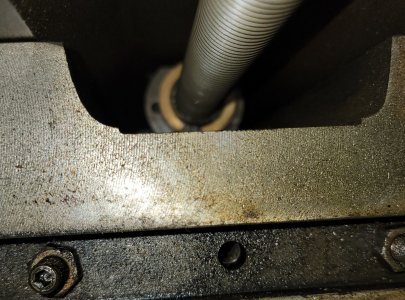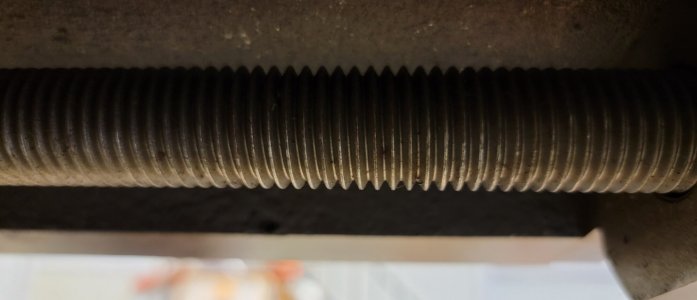I have heard about these oddball dials before - especially on older off shore machines.
Here is my best guess as to how they arrive at 110 divisions: the lead screw they used is likely metric. Something like a TR40x14(P7)LH. What that means is the nominal OD of the trapezoidal thread is 40mm. (Probably not that big of an OD, but you get the idea). It has a lead of 14mm per revolution, with a thread pitch of 7mm. That means it is a two start screw (14/7=2).
How does that give us 110 divisions on the dial? Well, 14mm is about 13.97mm. 13.97mm = 0.55” per turn. 0.55” / 110 = 0.005” for each division —> as is stamped on your dial. Hence the odd ball number of graduations.
I managed to hobble out to the shop this afternoon on my sprained ankle. My plan was to try and measure the lead screw pitch on the x & y axis so I could make a proper metric scale for it. I had no idea what kind of surprise laid in wait for me.
I discovered that it's actually an SAE 10tpi screw! Ten full turns equals 1 inch on both axis
That will make the job a lot easier. All I need is new SAE dials or at least new scales. I doubt they are hard to find but if so, I can always make new ones or even simply turn down and remark the existing ones. SAE dials will also probably increase the sale value a bit.
In fact, maybe I'll even try to make or fit some friction scales so I can set zero.
I confess that I am more than a bit embarrassed to have to admit to you guys that I never looked at this before. I did some quick measurements when I first got it, and then abandoned all use of the dials or counting turns because it was so whacky. I just used it by marking and measuring parts and didn't use the dials for anything at all. If I had known then that it was actually a 10 tpi screw, I would have fixed the scales many years ago.
But now I am more curious than ever about how it got those 11 graduation dials! What a weird mystery.......









